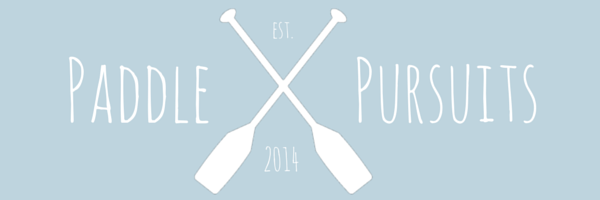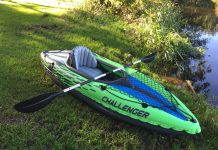
Let me ask you this: how long have you been thinking about paddle board surfing? What excites you about it? Is it the mastery of the waves and the force of nature? Or do you usually paddle a kayak and want to try something a little more “out there”?
Whatever your reason is, I’m sure once you begin, you’ll love paddle boarding as much as I do, or maybe even more. Kidding, not possible.
The first thing you need to know is anyone can learn to paddleboard. The majority of people can find their balance and perform the basic strokes after their first lesson.
And it’s relatively easy to give it crack. All you need is the gear (of course), a good coach, and some flat water to learn the ropes.
Choosing Your SUP Gear
Paddle boards come in many different shapes, sizes, and materials to suit the variety of ways they’ll be used. If this is your very first time paddle boarding, you’ll probably be renting a board, or you’ll have one supplied by your instructors if you’re taking lessons.
If you’ve bought your board (or even made one yourself), you’re probably a bit more experienced and know the basics of selecting a paddle board that suits your needs.
As a rule of thumb, the wider and thicker the board, the easier it will be to balance. Beginners boards will usually be at least 30” wide. Stick to a beginner board when learning as being able to balance easily will boost your confidence.
The next step is choosing a paddle. Pick a paddle that is about half a foot taller than you. Make it too long, and you can't use it. Make it too short, and you might as well be in a canoe.
A wetsuit is ideal, as it’ll protect your body from the elements and the cold slap of seawater. And yes, that means that you’re going to be falling into the water your fair share of times.
Before getting into the ocean, make sure your leash is fastened securely to your calf, just above your ankle. This will stop you from getting separated from your board when you take a tumble, and also stop your board from becoming a hazard to other surfers.
Now, let’s get to the lesson.
How Do I Stand Up?
It is in the name of the sport, so yes, learning to stand on the board is crucial. Some instructors would want you to practice the motions on dry land before getting out onto the water. But my guess is you want to skip all that. So…
Firstly, you have to pick the right spot. You want a sandy beach, void of rocks, reefs, and other physical dangers. Go where the water is calm.
You also want to keep a safe distance from other surfers or swimmers (but still within range of the lifeguards).
Hold your board as you get into the water with one hand and the paddle with the other. When you are in knee deep water, drop your board and climb on top of it. You’ll be fine kneeling on top of it. If you are not feeling sure, then you can lie on your stomach.
Your knees should be roughly in the middle of the board and nearer the edges for stability.
Next, paddle gently with smooth forward strokes while still on your knees.
Once you’re used to paddling from the low stance, run through the following steps slowly to stand up.
Place your paddle across the board and put your hands on top of the paddle at the edges of the board. Apply even pressure with both hands to keep the board balanced while you slowly, with one foot at a time, go from the kneeling to standing position.
Once standing, hold the paddle at the top T-bar handle with one hand, and at the center of the shaft with the other. Keep your arms stretched out in front of you, bending your elbows slightly, while also bending your knees slightly.
Now, practice the forward stroke just as you done when kneeling.
Hold tight and don’t let the water boss you around. And once you’re feeling comfortable, try changing direction and rotating 360 degrees by using a wider arc with your strokes.
And voila, you’re paddleboarding.
Paddling Over Waves
Now we’re getting to the good stuff. So you’re on your feet, and you’re paddling, then you notice a dwarf wave coming towards you. What do you do?
Your natural inclination may be to get back down on your knees where it’s safe.
But you’re not going to give in to fear.
As the wave approaches, paddle a bit faster, standing towards the rear of the board, so the nose gets up and over the wave. As the wave gets to you, make one final paddle to give you the momentum to go over the hump while maintaining your balance.
After breaking through the wave, the temptation will be there to give yourself a celebratory clap, but wait, there’s more.
Waves come in sets, so in all likelihood, you’d have to do this at least two more times to pass the first hurdle.
Before going any further, be clear that we’re only attempting this on knee-high waves. As with running, you must first learn to walk. Strong waves are dangerous even for professional swimmers and surfers, so don’t be hasty.
Riding the Waves

This is how you SUP surf (Image: www.standuppaddleboardhq.com)
As I mentioned earlier, waves come in sets. What you want to do is position yourself for the wave you want to catch.
So after you’ve paddled out to where the larger waves are (waist-high at most), you need to find where it’s going to break.
When you’re at the sweet spot, turn your board and face the beach. As the wave comes, paddle quickly, parallel to the wave and let it pick you up. The waves will move you either towards the left or the right, so go with the flow.
Before you ride the wave, you should be standing towards the middle of your board, but as it comes, you should take a step back. Standing at the rear makes it easier to steer while the wave does the heavy lifting.
You don’t need to paddle much when on the wave, just enough to give you balance or change direction.
When you want to turn, stick your paddle into the wave behind you - on your right side if you want to turn right - and that will swing you in the direction of the wave. Once you’re flowing, you can resume paddling by your side as normal, if required.
The waves come in often so don’t worry if you miss a few. Remember, you want to start off easy.
If you feel yourself tipping over, lean forward and don’t panic. Depending on the direction of the waves, you may need to change your stance on the board, but baby steps.
How to Dismount
It seems pretty straightforward, but let me clarify a few things. As you move towards the beach, on a low or high current, you must return to the kneeling position.
If your momentum is too strong and you find yourself approaching the shoreline quickly, sit at the back of your board.
Once you get back to knee-high water, dismount and pick your board up. Don’t wait until you get to shore because the water might pull you back out and you could slip.
Congratulations, you’ve just caught your first wave!
Now you’ve got a handle on the process, check out this video for some SUP surfing tips:
Conclusion
Hopefully, you’ve managed to ride the surf following our beginner's guide. Paddleboard surfing is crazy addictive, and no doubt you’ll be hooked on catching waves after your first successful ride.
Remember, stick to waist-high waves until you’re much more experienced. And if you do want to learn how to paddle board surf like a pro, get yourself booked in for an advanced class with a qualified instructor.
If you’ve tried SUP surfing for the first time recently, let us know how you found it in the comments below.
As an Amazon Associate, we earn from qualifying purchases. This is without any additional costs for the buyer but does support us in maintaining our website.



